Chapter 7
How to Plant Your Lunch

Most plants grow from seeds. And where do you find seeds?
No, not in packets in the garden centre – you’ll find a few seeds there – but most of the seeds in the world are still in the fruit where they grew. Any grotty bit of fruit in your lunch box – except bananas – has seeds in it. If you plant them they’ll grow!
If you spit out the seeds from any fruit, chances are you’ll be able to grow it and eventually harvest more fruit when it grows into a tree or bush.
Will the fruit be just like the one I ate?
Maybe not. Most fruit have two parents just like you do. You don’t look just like your mum and dad, you look like a mixture of lots of ancestors – and most plants do too.
On the other hand, the ‘parents’ of most fruit look much more like each other than your mum and dad do so the chances are any fruit you grow from seed will look pretty much like the one whose seed you planted.
I’ve grown hundreds of fruit trees from seed and every time I’ve grown something that tastes good.
How long will it take before I get fruit?
That depends. It usually takes four or five years to get fruit from a fruit tree, but only a few months to get fruit from a watermelon or rockmelon. (See page 35 for how to grow a watermelon or Chapter Three for how to grow a fruit tree.)
What seeds can I plant?
Look in the cupboard and the fridge or wander through the supermarket.
Some of the ‘seeds’ you’ll see will be:
- Oranges, lemons, grapefruit, mandarins – plant these straightaway.
- Apples, plums, peaches, nectarines, apricots, pears and other fruit seeds from trees that lose their leaves in winter – keep these in the fridge for three weeks before you plant them, so they think they’ve gone through winter. You can either keep them in the fridge still in their piece of fruit, or take the seeds out and keep them in dry sand. (If the seeds look small and twisted they probably won’t grow.)
- Avocados – these germinate (grow) best if they’re kept in semi-shade. A windowsill is great.
- Peanuts – if they’re still in their shell (not roasted) they’ll probably grow. Plant them in spring.
- Watermelon and rockmelon – they have to be really ripe before the seed will grow. Plant the seed in spring or when you know there’ll be at least five hot months to come.
- Pumpkin – same as rockmelon and watermelon.
- Sweet potatoes – sweet potatoes grow from sweet potato roots (which is the part you eat) so if you plant a sweet potato in spring to midsummer, you’ll get lots more growing under the ground. You can only grow sweet potato in climates as warm or warmer than Brisbane.
- Ginger – just like sweet potato.
- Tomatoes – chop up the tomato and squeeze the seeds into a glass. Cover the seeds with water and put the glass on the windowsill for three weeks. It will all go disgusting and gluggy.
At the end of three weeks wash the seeds and now you can plant them, because the ‘fermenting’ killed any disease the tomato might have had. (You can usually just plant a tiny cherry tomato though and it’ll grow into more cherry tomato bushes.) - Chillies – really ripe, red chillies usually have seeds that will grow into more chilli bushes.
- Dates – if you plant seeds from fresh dates, they’ll often grow. (You need a male and a female date tree to get dates – so grow at least four trees so you have a better chance of having one of each.)
- Coconut – if you have a fresh coconut, put it in a plastic bag in the sun till tiny roots grow out of it, then plant it. (But coconuts only grow if the climate is as hot or hotter than Brisbane.)
- Chokoes – if you plant a choko you get a choko vine. (See page 114.)
- Potatoes – same as chokoes. (See page 105.)
- Macadamias – plant a fresh nut still in its shell and, with luck, you’ll get a nut tree. (See page 78.)
- Pawpaws – these grow really easily from the seeds of fresh ripe pawpaws. But the climate has to be as warm as Brisbane, or warmer, for them to grow.
- Seeds – there are many foods that we still eat as seeds without grinding, rolling or roasting first. Try sesame (a fragile-looking little climber), sunflower (a sturdy, tall flower), bird seed, whole oats, wheat, barley, mustard etc.
- Fresh (unpickled) olives can sometimes be found in the markets. They germinate readily (in fact in some areas they have invaded the bush and become weeds) and grow into handsome trees which bear heavy crops in most parts of Australia.
There are probably lots of others I’ve missed that you can think of – or will find if you wander around the fruit section in the supermarket.
On the other hand, don’t bother with:
- Strawberries – only a few types of strawberry grow from seed. (You can buy the seed in packets – don’t try to scrape the tiny seeds off strawberries.)
- Bananas – these grow from ‘suckers’ which are the new shoots growing out of the roots of the old plants. Wild bananas grow from seed – the little black things in the middle of the bananas you eat. But the bananas for sale in shops will never grow into trees which will bear fruit.
- Almonds, walnuts and chestnuts – these have probably been heated or bleached so they look good and the ‘seed’ has been killed in the process.
- Sometimes I’ve managed to get soybeans from the supermarket to grow into soybean plants; or some of the spices such as coriander seeds. Most often though they’re too stale to grow or they’ve been treated so they can’t grow.
- Grapes grow from seeds but the easiest way to grow a grape vine is to take a cutting of the dead-looking wood in winter (a piece with at least three ‘nodes’ – when you look at the vine you’ll see what a node is) and plant it two nodes deep in a pot. Then keep it moist in semi-shade for a year and plant it out next winter.
Most of our grapes (we have eight bushes) grew from cuttings. Don’t bring cuttings into an area where they grow grapes commercially, because you might bring in a grape disease or pest that can ruin the vines! (Pests like to hitchhike into new areas!)
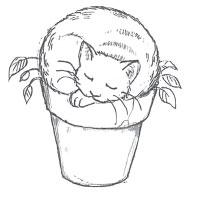
What’s the best way to grow seeds?
You need: a styrofoam box with holes in the bottom; soil or potting mix; ice-block sticks.
Step 1. Fill the box with soil or potting mix. Potting mix is the best to use as it won’t have lots of weed seeds in it whereas soil often does. If you want to kill weed seeds in soil, place the soil on a baking tray in the oven with a medium-sized potato. When the potato is cooked the weed seeds are dead!

Step 2. Scatter the seeds – big seeds should be further apart than little seeds. Each seed should be at least four times its size away from the next seed.
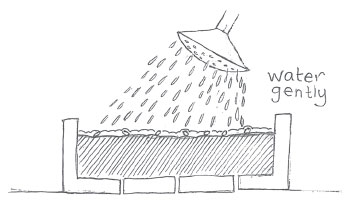
Step 3. Scatter a tiny bit of potting mix on the seeds.
Step 4. Water well, but gently, or the seeds and soil will splash over the box, or you’ll wash all the seeds together in clumps.
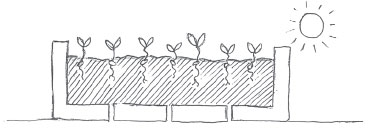
Step 5. Keep in the sun or light shade till the seeds germinate.
Most seeds will germinate in about a week or two. Wait at least two months. Some seeds take over a year to germinate. You’ll probably decide not to wait for them but if you can be bothered, you might get some surprises.
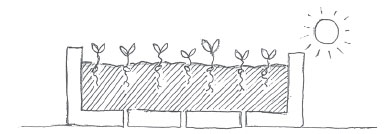
Step 6. Label each lot of seeds by writing the name on an ice-block stick and sticking it into the soil next to them, so you know what comes up. (No, you won’t remember – I never do, even if I’m sure I’m going to.)
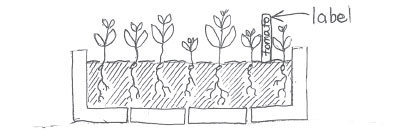
Step 7. From now on it’s really a sort of lucky dip – wait and see what happens.
And if you don’t want them all they’ll make great presents.